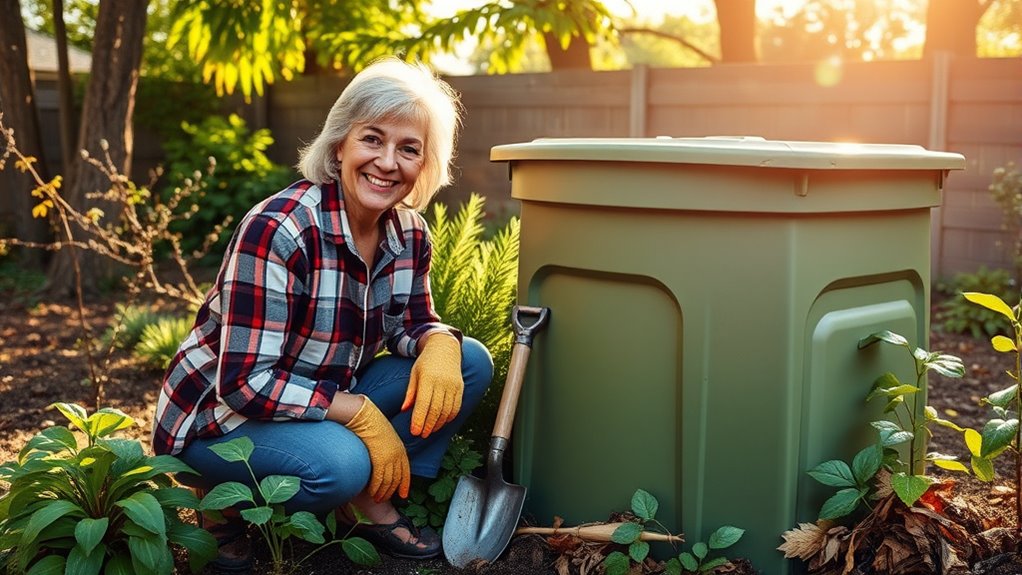Composting is an easy way for you to reduce waste and help the environment. To start, find a shady, flat spot away from your home’s foundation. Use a simple bin filled with kitchen scraps like vegetable peels, coffee grounds, and yard waste such as leaves or grass. Cover food scraps with brown materials to keep pests away. Regularly turn and water your compost to help it break down faster. Keep practicing these simple steps to make composting a rewarding part of your routine.
Key Takeaways
- Place your compost bin in a shady, well-drained spot away from your home to promote efficient decomposition and prevent odors.
- Use a mix of kitchen scraps (vegetable peels, coffee grounds) and yard waste (leaves, grass) with browns to balance moisture and nutrients.
- Avoid adding meat, dairy, or oily foods to reduce pest attraction; cover food scraps with dry materials like straw or leaves.
- Turn the compost regularly to aerate and maintain proper moisture, helping waste break down faster and smell less.
- Start with a small bin, learn basic techniques, and enjoy eco-friendly activity that reduces waste and enriches your garden.

Getting started with composting can be a rewarding way for seniors to reduce waste and support a healthier environment. It’s a simple activity that transforms kitchen scraps and yard waste into nutrient-rich compost, which can improve your garden’s health. However, to guarantee your composting efforts are successful, paying attention to compost bin placement is essential. Position your bin in a well-drained, shady spot to regulate moisture levels and prevent it from becoming too hot or too soggy. Avoid placing it directly in full sun, as excessive heat can slow down the composting process. Also, keep it away from your home’s foundation to avoid any odors or pests from becoming an issue.
Place your compost bin in a shady, well-drained spot away from your home’s foundation for best results.
One common concern when composting is managing garden pests. You might worry about pests like rodents, raccoons, or insects being attracted to your compost bin. To minimize this risk, avoid adding meat, dairy, or oily foods that tend to attract pests. Instead, stick to vegetable scraps, coffee grounds, eggshells, grass clippings, and leaves. Covering food scraps with a layer of browns, like dried leaves or straw, creates a barrier that discourages pests from digging into your compost. Also, regularly turning your compost can help aerate it and reduce odors that attract unwanted visitors. Proper bin placement plays a big role here; placing your bin on a flat, stable surface and near natural barriers like shrubs or fences can help keep pests at bay. If pests become a persistent problem, consider using a sealed, enclosed compost bin designed to keep pests out. Additionally, educating yourself about composting techniques can help you troubleshoot issues and improve your results over time. Incorporating knowledge about pest management into your routine can further enhance your composting success.
Furthermore, understanding the importance of proper bin placement and its effect on pest control can significantly enhance your composting success. As you become more familiar with composting, you’ll notice the importance of maintaining the right balance of greens and browns—kitchen scraps and grass clippings versus dried leaves and paper. This balance helps control odors and deters pests, making the process more enjoyable. Remember to keep your compost moist, similar to a damp sponge, not too wet or dry. Regularly checking and adjusting the moisture and aeration will speed up decomposition and keep your compost healthy.
Starting small with a manageable bin size allows you to get used to the process without feeling overwhelmed. Over time, you’ll see how proper compost bin placement and pest management make composting easier and more effective. It’s a simple, eco-friendly activity that offers many benefits, from reducing waste to nourishing your garden plants. With a little attention to details like bin location and pest prevention, you’ll enjoy a sustainable practice that benefits both you and the environment.
Frequently Asked Questions
Can Seniors Compost Indoors Safely?
Yes, seniors can compost indoors safely by choosing a well-ventilated space to maintain indoor air quality. Place the compost bin in a cool, dry spot away from living areas to prevent odors and pests. Use a sealed bin with proper airflow, and turn the compost regularly. This way, you enjoy composting benefits without compromising indoor air quality or comfort, making indoor composting a simple, eco-friendly activity.
What Tools Are Best for Senior Composters?
Ever wonder which tools make composting easier for you? The secret lies in choosing the right composting tools, especially senior-friendly compost bins designed for easy use and minimal effort. Look for bins with secure lids, smooth edges, and simple aeration systems. These features help you manage compost safely and comfortably. With the right tools, you’ll find composting becomes a rewarding, effortless activity—turning waste into rich soil with ease.
How Much Maintenance Does Composting Require?
You might wonder about the maintenance frequency needed for compost management. It’s fairly minimal; you’ll need to turn the compost every few weeks to keep it aerated and ensure proper decomposition. Regularly monitor moisture levels—adding water if it’s too dry or dry materials if it’s too wet. Overall, composting requires just a bit of effort to keep the process smooth, making it manageable for seniors to enjoy the benefits of compost management.
Are There Composting Programs for Seniors?
Did you know over 60% of communities offer programs for seniors interested in composting? Many community programs and compost workshops are specifically designed for older adults, making it easier for you to join. These programs provide hands-on guidance and resources, so you don’t feel overwhelmed. You can learn simple methods to reduce waste, connect with neighbors, and contribute positively to the environment—all at your own pace.
How Can Seniors Prevent Pests in Compost Bins?
To prevent pests in your compost bin, you should focus on effective pest deterrent strategies and compost bin security. Make sure to cover food scraps with brown materials like leaves or shredded paper, and avoid adding meat or dairy. Keep the bin sealed tightly, and place it in a secure, less accessible spot. Regularly turning the compost also discourages pests, helping you maintain a clean, pest-free environment.
Conclusion
So, after all this, you might think composting is just for the young and agile. But here you are, proving that seniors can turn kitchen scraps into garden gold too! It’s funny how something so simple can be overlooked, yet it’s actually one of the easiest ways to help the planet. So go ahead—embrace composting. Who knew that reducing waste could be your new favorite pastime, and maybe even save the world a little at a time?









